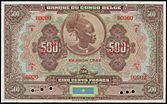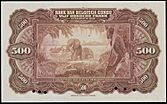Congolese franc facts for kids
Quick facts for kids Congolese franc |
|
|---|---|
| ISO 4217 Code | CDF |
| User(s) | Formerly: |
| Inflation | 9.27% |
| Source | [1], 2022 |
| Subunit | |
| 1⁄100 | centime |
| Symbol | FC |
| Banknotes | 1, 5, 10, 20, 50 centimes, 1, 5, 10, 20, 50, 100, 200, 500, 1,000, 5,000, 10,000, 20,000 francs |
The Congolese franc (called franc congolais in French) is the official money used in the Democratic Republic of the Congo. It is divided into 100 smaller parts called centimes. However, centimes are not really used anymore because they are worth so little. In April 2024, about 2,800 Congolese francs were equal to one US dollar.
Contents
The First Franc (1887–1967)
The first Congolese franc was created in 1887. It was used in a place called the Congo Free State, which was later taken over by Belgium and became the Belgian Congo. This money was worth the same as the Belgian franc.
From 1916, the Congolese franc was also used in Ruanda-Urundi, which are now the countries of Rwanda and Burundi. Later, in 1952, the money was made for both the Belgian Congo and Ruanda-Urundi together.
After the Democratic Republic of the Congo became independent in 1960, Ruanda-Urundi started using its own money. For a few years (1960-1963), a region called Katanga also had its own special franc.
The first banknotes (paper money) for the Congo Free State were printed in 1896. They were issued by the General Treasury of the Congo Free State.
From 1908 to 1960, even though the Congolese franc was the only money people actually used in the Belgian Congo, some people argued it wasn't officially a separate currency. They thought it was just a way to represent Belgian francs.
In 1911, a private bank called the Bank of the Belgian Congo was allowed to print banknotes. These notes could be exchanged for gold or other foreign money. This stopped during World War I but started again in 1927. The value of the Congolese franc changed during World War II. After that war, the Congolese franc and Belgian franc were still linked. In 1951, a central bank was created to manage the money.
The franc stayed as Congo's money after it became independent in 1960. But its value slowly dropped compared to the Belgian franc. In 1967, a new currency called the zaïre was introduced. One zaïre was worth 1,000 old francs.
Old Coins
In 1887, the first coins were made. They were copper coins with a hole in the middle, in values like 1, 2, 5, and 10 centimes. There were also silver coins for 50 centimes, and 1, 2, and 5 francs. Silver coins stopped being made in 1896.
New coins were introduced over the years. For example, in 1906, 5, 10, and 20 centime coins were made from a mix of copper and nickel. In 1920 and 1921, 50 centime and 1 franc coins were made from the same metal mix.
Coin production for the Belgian Congo stopped in 1929 but started again in 1936 and 1937 with 5 franc coins made of nickel-bronze. During the 1940s, different coins were made, including 2 franc coins that were shaped like hexagons (six-sided).
In 1952, 5-franc coins were made that included the name "Ruanda-Urundi" for the first time. Later, between 1954 and 1957, coins made of aluminum were issued for 50 centimes, 1, and 5 francs. The last franc coins from this period were 10-franc aluminum coins made in 1965.
Just like Belgium's own coins, some of these coins had two versions: one with French words and another with Dutch words.
Old Banknotes
The Congo Free State first issued 10 and 100 franc banknotes in 1896. The Bank of Belgian Congo started printing 20 and 1000 franc notes in 1912, and then 1, 5, and 100 franc notes in 1914. Over the years, more values were added, like 500 francs in the 1940s and 10,000 francs in 1942.
In 1952, the Central Bank of Belgian Congo and Ruanda-Urundi began issuing banknotes for 5, 10, 20, 50, and 100 francs. They added 500 and 1000 franc notes in 1953.
After independence, the National Bank of Congo issued new notes from 1961 to 1964. Some 1000 franc notes from the Central Bank of Belgian Congo and Ruanda-Urundi were even stamped with the new Monetary Council's name in 1962.
The Second Franc (1997–Present)
The franc was brought back in 1997. It replaced the new zaïre at a very high rate: 1 franc was equal to 100,000 new zaïres. This was like saying 1 franc was worth 300 trillion of the very old francs!
New Coins
No coins have been made for the second franc. Even the smallest values, like 1, 5, 10, 20, and 50 centimes, were only printed as paper money (banknotes).
New Banknotes
New banknotes were introduced on June 30, 1998, though they all had the date November 1, 1997. These included values like 1, 5, 10, 20, and 50 centimes, and 1, 5, 10, 20, 50, and 100 francs. Later, 200-franc notes came out in 2000, and 500-franc notes in 2002.
Today, the most common banknotes you'll see in the Democratic Republic of the Congo are 10, 20, 50, 100, 200, 500, 1,000, 5,000, 10,000, and 20,000 francs. The smallest note that is widely used is the 50-franc note.
In 2010, the Central Bank of the Congo printed 20 million special 500-franc banknotes. These were made to celebrate the country's 50th anniversary of becoming independent from Belgium.
On July 2, 2012, the Central Bank of the Congo released even newer banknotes for 1,000, 5,000, 10,000, and 20,000 francs.
| Banknotes of the Congolese franc (01.11.1997 issue) | |||||
|---|---|---|---|---|---|
| Image | Value | Main color | What's on the front? | What's on the back? | Special security feature |
| [2] | 1 centime | Green, purple, brown | Coffee harvest | Nyiragongo volcano | Okapi head |
| [3] | 5 centimes | Purple | Suku mask | Zande harp | Okapi head |
| [4] | 10 centimes | Red-purple, dark-brown | Pende mask | Pende dancers | Okapi head |
| [5] | 20 centimes | Blue-green, black | Antelope | Upemba National Park | Okapi head |
| [6] | 50 centimes | Dark brown, brown | Okapi | Okapis at Epulu Okapi Reserve | Okapi head |
| [7] | 1 franc | Deep purple, blue-purple | Copper factory | Patrice Lumumba after his capture | Okapi head |
| [8] | 5 francs | Purple, black | Rhinoceros, Garamba National Park | Kamwanga falls | Okapi head |
| [9] | 10 francs | Red-purple | Luba carving "Tête-à-Tête" | Luba carving | Okapi head |
| [10] | 20 francs | Brown-orange, red-orange | Lion, Kundelongu Park | Lioness with her cubs, Kundelongu Park | Okapi head |
| [11] | 50 francs | Blue-Purple | Tshokwe mask "Mwana Pwo" | Fishermen's village along the Congo River | Okapi head |
| [12] | 100 francs | Red | Elephant, Virunga National Park | "Inga II" hydroelectric dam | Okapi head |
| Banknotes of the Congolese franc (04.01.2000 issue) | |||||
|---|---|---|---|---|---|
| Image | Value | Main color | What's on the front? | What's on the back? | Special security feature |
| 50 francs | Lilac-brown | Tshokwe mask "Mwana Pwo" | Fishermen's village along the Congo River | Okapi head | |
| 100 francs | Slate blue | Elephant, Virunga National Park | "Inga II" hydroelectric dam | Okapi head | |
| Banknotes of the Congolese franc (30.06.2000 & 04.01.2002 (2003) issues) | |||||
|---|---|---|---|---|---|
| Image | Value | Main color | What's on the front? | What's on the back? | Special security feature |
| [13] | 200 francs | Lilac, olive-green | Fieldwork | Drummers | Okapi head |
| [14] | 500 francs | Blue | Diamond mining | Diamond mining, Etroite Valley | Okapi head |
| Banknotes of the Congolese franc (02.02.2005 & 18.02.2006 (2012) issues) | |||||
|---|---|---|---|---|---|
| Image | Value | Main color | What's on the front? | What's on the back? | Special security feature |
| [15] | 1000 francs | Green | Okapi, Kanioka box | Grey parrot; yellow corn | Okapi and "1000" |
| [16] | 5000 francs | Brown | Zebras; Hemba statuette | Bowl; bundles of maniok; two helmeted guineafowl | Okapi and "5000" |
| [17] | 10,000 francs | Violet | Two wildebeest; carved statuette | Bird on a branch; banana trees | Okapi and "10,000" |
| [18] | 20,000 francs | Yellow | Giraffes; carved head "Bashilele" | Palm trees; date clusters; two grey crowned cranes | Leopard head and "20,000" |
| Current CDF exchange rates | |
|---|---|
| From Google Finance: | AUD CAD CHF EUR GBP HKD JPY USD XAF ZAR |
| From Yahoo! Finance: | AUD CAD CHF EUR GBP HKD JPY USD XAF ZAR |
| From XE.com: | AUD CAD CHF EUR GBP HKD JPY USD XAF ZAR |
| From OANDA: | AUD CAD CHF EUR GBP HKD JPY USD XAF ZAR |
| From fxtop.com: | AUD CAD CHF EUR GBP HKD JPY USD XAF ZAR |
See also
- Economy of the Democratic Republic of the Congo
- CFA franc
- Comorian franc
- Djiboutian franc
- Swiss franc
Images for kids






